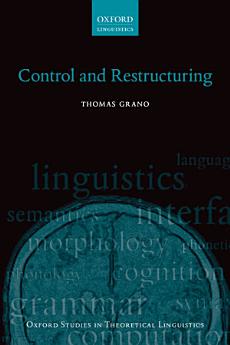Control and Restructuring
ਮਾਰਚ 2015 · Oxford Studies in Theoretical Linguistics ਕਿਤਾਬ 56 · OUP Oxford
ਈ-ਕਿਤਾਬ
304
ਪੰਨੇ
family_home
ਯੋਗ
info
reportਰੇਟਿੰਗਾਂ ਅਤੇ ਸਮੀਖਿਆਵਾਂ ਦੀ ਪੁਸ਼ਟੀ ਨਹੀਂ ਕੀਤੀ ਗਈ ਹੈ ਹੋਰ ਜਾਣੋ
ਇਸ ਈ-ਕਿਤਾਬ ਬਾਰੇ
This book investigates the phenomenon of control structures, configurations in which the subject of the embedded clause is missing and is construed as coreferential with the subject of the embedding clause (e.g. John wanted to leave). It draws on data from English, Mandarin Chinese, and Modern Greek to investigate the relationship that control bears both to restructuring - the phenomenon whereby some apparently biclausal structures behave as though they constitute just one clause - and to the meanings of the embedding predicates that participate in these structures. Thomas Grano argues that restructuring is cross-linguistically pervasive and that, by virtue of its co-occurrence with some control predicates but not others, it serves as evidence for a basic division within the class of complement control structures. This division is connected to how the semantics of the control predicate interacts with general principles of clausal architecture and of the syntax-semantics interface. His findings have general implications both for clausal structure and for the relationship between form and meaning in natural language.
ਲੇਖਕ ਬਾਰੇ
Thomas Grano is Assistant Professor of Linguistics at Indiana University. He received his PhD from the University of Chicago in 2012, and he specializes in semantics and syntax, with particular attention to clausal complementation, gradability and comparison, and Mandarin Chinese. His work has appeared in journals such as Journal of East Asian Linguistics, Natural Language & Linguistic Theory, and Natural Language Semantics.
ਇਸ ਈ-ਕਿਤਾਬ ਨੂੰ ਰੇਟ ਕਰੋ
ਆਪਣੇ ਵਿਚਾਰ ਦੱਸੋ
ਪੜ੍ਹਨ ਸੰਬੰਧੀ ਜਾਣਕਾਰੀ
ਸਮਾਰਟਫ਼ੋਨ ਅਤੇ ਟੈਬਲੈੱਟ
Google Play Books ਐਪ ਨੂੰ Android ਅਤੇ iPad/iPhone ਲਈ ਸਥਾਪਤ ਕਰੋ। ਇਹ ਤੁਹਾਡੇ ਖਾਤੇ ਨਾਲ ਸਵੈਚਲਿਤ ਤੌਰ 'ਤੇ ਸਿੰਕ ਕਰਦੀ ਹੈ ਅਤੇ ਤੁਹਾਨੂੰ ਕਿਤੋਂ ਵੀ ਆਨਲਾਈਨ ਜਾਂ ਆਫ਼ਲਾਈਨ ਪੜ੍ਹਨ ਦਿੰਦੀ ਹੈ।
ਲੈਪਟਾਪ ਅਤੇ ਕੰਪਿਊਟਰ
ਤੁਸੀਂ ਆਪਣੇ ਕੰਪਿਊਟਰ ਦਾ ਵੈੱਬ ਬ੍ਰਾਊਜ਼ਰ ਵਰਤਦੇ ਹੋਏ Google Play 'ਤੇ ਖਰੀਦੀਆਂ ਗਈਆਂ ਆਡੀਓ-ਕਿਤਾਬਾਂ ਸੁਣ ਸਕਦੇ ਹੋ।
eReaders ਅਤੇ ਹੋਰ ਡੀਵਾਈਸਾਂ
e-ink ਡੀਵਾਈਸਾਂ 'ਤੇ ਪੜ੍ਹਨ ਲਈ ਜਿਵੇਂ Kobo eReaders, ਤੁਹਾਨੂੰ ਫ਼ਾਈਲ ਡਾਊਨਲੋਡ ਕਰਨ ਅਤੇ ਇਸਨੂੰ ਆਪਣੇ ਡੀਵਾਈਸ 'ਤੇ ਟ੍ਰਾਂਸਫਰ ਕਰਨ ਦੀ ਲੋੜ ਹੋਵੇਗੀ। ਸਮਰਥਿਤ eReaders 'ਤੇ ਫ਼ਾਈਲਾਂ ਟ੍ਰਾਂਸਫਰ ਕਰਨ ਲਈ ਵੇਰਵੇ ਸਹਿਤ ਮਦਦ ਕੇਂਦਰ ਹਿਦਾਇਤਾਂ ਦੀ ਪਾਲਣਾ ਕਰੋ।







